
Search Begins Again for 'Greatest Game'
August 27, 2016
By Ron Pesch
Special for Second Half
There really is no place I’d rather be than in the stands of a high school football stadium on a Friday night. As summer fades to autumn, and leaves begin to fall, the smile on my face grows. It’s football weather. The days shorten and the hue of the evening sky deepens; the air turns crisp; hoodies come out; hot dogs and popcorn bring more joy than a finely catered meal. As the season progresses, hot chocolate becomes a drink to be cherished and appreciated.
As I’ve aged, my interest in the professional game has faded. My fascination with the college game continues to dwindle in direct relation to the increasing prices for a ticket to a game, the marketing hype generated by the changing of brands for overpriced athletic apparel and the escalating dollars involved in signing a coach.
The prep season presents the chance to step outside to enjoy my favorite part of the calendar. I’ll sit beneath lights, watching high school kids struggle with, then grasp, the components of the game. On some nights, I’ll again witness pure athleticism shred the defense of an unprepared squad. On others, I’ll watch a finely schooled team dismantle superior size and speed.
From those prep stands, I’ll continue to see moments where the underdog defeats the favorite; where the ordinary achieves the extraordinary; where tension and excitement erupts into a roar. I’ll stand and cheer as the high school band, enjoying its share of the spotlight, takes the field to play the national anthem and showcase its skills at halftime.
And again this season, I’ll settle in with hopes of finding the game I can call the greatest in state high school history.
My criteria is stringent, perhaps more stringent than the conditions held by others.
1) The margin should be close, ideally through most of the 48 minutes that comprise a contest. I’m really no fan of overtime.
2) The stakes should be high. Hence, this may favor late-season contests, where playoff implications and/or league championships are involved.
3) There should be history, where past battles between the schools have helped to establish a palatable dislike for the other, when the teams line up for a contest. Cross-town rivalries, where bragging rights and perhaps a trophy, are involved, enhance the value in my eyes. At the same time, playoff rivalries, where defeat is balanced between each, or where dominance by a single school is suddenly shattered, augment the importance of such a contest.
4) Weather conditions and controversy should not be a factor.
Over the years, I’ve watched or read about amazing comebacks, decisive thrashings, contests played under vicious weather conditions and marathon overtime battles. Each, some might argue, are challengers to the crown.
But I have yet to find a replacement for the current title-holder – a game played before my birth.
The reigning champ was christened as such by an authority. I’ve seen a small segment of that 1945 season-ending battle between Muskegon High School and Muskegon Heights High School, as captured by a home movie camera. In addition, I’ve viewed a series of amazing still photographs that portray the drama.
I’ll let the legendary Hal Schram set the stage.
“Seldom has one city dominated Michigan high school football as completely as Muskegon does this week,” stated the Detroit Free Press writer later known as “The Swami” for his tongue-in-cheek “all-knowing” ways when it came to predicting high school sports outcomes.
Schram’s Tuesday, November 6 column in the Free Press included his Class A Top Ten rankings. The Top Ten, used to identify the state’s best team based on enrollment classification, win-loss record and strength of schedule, was a relatively new approach to identifying the state’s best. The approach is still in use today.
“One month ago, Muskegon High occupied second place in the Top Ten while Muskegon Heights ranked sixth,” said Schram. “Today, Coach Leo Redmond’s Big Reds with a 16-game winning streak, and the Heights, with the best defensive record in state Class A football, rate first and second respectively.”
A week later, Schram’s ranking in the Free Press reflected the same result in Class A, heading into the season’s final week.
 “Twenty-thousand Muskegon fans will watch their high school giants – Muskegon and Muskegon Heights – battle for a mythical Michigan championship Saturday. Only the limited seating capacity of the city’s Hackley Stadium prevents the attendance from reaching 30,000. Reserve seat tickets have been completely sold out for three weeks.
“Twenty-thousand Muskegon fans will watch their high school giants – Muskegon and Muskegon Heights – battle for a mythical Michigan championship Saturday. Only the limited seating capacity of the city’s Hackley Stadium prevents the attendance from reaching 30,000. Reserve seat tickets have been completely sold out for three weeks.
“Muskegon, with its 17-game winning streak, clings to its No. 1 rating among Michigan high schools for the third straight week, but the difference between the Big Reds and the Heights is infinitesimal.
“The Big Reds have scored 191 points to 38 for eight opponents while Muskegon Heights has rolled up 185 points to 37. Both have played almost exactly the same opponents and under identical conditions …
“The Heights will be gunning for its first triumph since 1943 over Muskegon, when the Tigers won, 7-0. The victor will also lay claim to the Southwestern Conference championship.”
It would take 30 years before the MHSAA created a playoff system to determine football state champions. Until that time, state titles were dispensed by the media, and hence were referred to as mythical, since they weren’t settled in a series of head-to-head contests played between contenders.
A total of 18 Big Reds and 23 Tigers would appear in their interscholastic football uniform for the final time. Eight seniors and three juniors would start the game for each team.
While the overall series dating back to 1922 favored Muskegon, in games played since 1930, the two teams were exactly even with each team having six victories and two ties over those previous 14 games. Coach Redmond had led the Big Reds since 1925. Oscar E. “Okie” Johnson took charge of the Heights in 1927 and would guide the Tigers until retirement following the 1963 season. The two coaches had been football teammates at Western State Normal School (today, Western Michigan University). Each coach had led their team to mythical state crowns in years past.
Statewide coverage of the pending heavy-weight battle enticed many from around the state to attend the game. A crowd of 13,500 – still the largest ever to visit Hackley – packed nearly every square inch of the stadium, bleachers and field. Countless others tuned in to the radio broadcast.
Servicemen, recently returned from World War II, helped hoist the flag during pregame ceremonies. The combined marching bands from each school opened the 2 p.m. program with the national anthem, and each entertained the crowd at halftime.
Muskegon won the toss and kicked off. The Heights unleashed their power early. Behind the running of Ed Petrongelli and backfield mate Paul Hulka, the Tigers rolled across mid-field, before a Petrongelli pass was picked off by Bob Clark on the Muskegon 15. The Big Reds were held on downs, and were forced to kick. Muskegon’s Bob Sikkenga, who averaged 30 yards on five punts during the day, gained a mere nine yards on his first kick of the afternoon, allowing the Heights to take control at the Muskegon 27. Petrongelli pounded ahead for four yards to the 23 before Jim Howell skirted the left side on the end around for the first score of the contest. Dorr Grover's placement was accurate, and Okie Johnson's Tigers led 7-0.
Muskegon bounced back, scoring midway through the second quarter of play. Starting at their own 35-yard line, Coach Redmond's backfield of Percy Moore, Bob McNitt and Howard Peterson alternated carries, pushing the ball to the Heights 31-yard line. Facing a 3rd-and-1 situation, Don Ohs replaced McNitt, and broke through off right guard for a first down on the Tiger 14. A Heights penalty advanced the ball to the 9. A pair of plays eked out only a yard, then McNitt was nailed behind the line on third down for a six-yard loss. Facing a 4th-and-goal, Peterson shot a pass toward McNitt at the goal line. Nearly intercepted by Ray McLean of the Tigers, the ball bounced into the waiting hands of the Muskegon back, and the Big Reds were a point away from a tie. But Tom Carr's kick went wide and low, and the Tigers clung to a one-point lead when the teams broke for the halftime intermission.
Much of the third quarter was played in Muskegon territory, with the Heights dominating. Still, neither team scored. As the teams entered the final quarter, a single point still separated victory from defeat.
Midway through the fourth, opportunity knocked for the Tigers as Jim Dotson recovered a Muskegon fumble on the Big Red 43. The Heights fans roared in approval as the Tiger offense lined up for action. But the momentum changed quickly as the Big Reds' Bob Anderson pounced on a Heights' fumble at the Tiger 48 on the first play from scrimmage.
 Redmond's squad went to the air. An incomplete pass was followed by a six-yard gain by Ted Barrett around left end. Another incomplete pass brought fourth down before Peterson found Bob Lintjer at the 30 yard line and he raced to the Heights 9, securing the first down.
Redmond's squad went to the air. An incomplete pass was followed by a six-yard gain by Ted Barrett around left end. Another incomplete pass brought fourth down before Peterson found Bob Lintjer at the 30 yard line and he raced to the Heights 9, securing the first down.
The Big Reds were hit for a five-yard penalty on a substitution, so the squad lined up for a 1st-and-goal from the 14. Barrett quickly made up for the penalty, battling to the 4 yard line. On 2nd and goal, Muskegon again went to Barrett, who picked up three yards. Injured on the play, the halfback exited the game with the ball resting on the 1 yard line.
"On (the) last two plays rode the hopes of 13,500 fans, for or against the success of the attacking Big Reds," wrote Muskegon Chronicle sports editor, James F. Henderson. "On those two plays rode both State and Southwestern titles."
McNitt charged the center of the line on third down, but was stopped three inches from the end zone. Redmond's squad huddled to discuss its final play.
“We decided to go with a quarterback sneak on fourth," recalled Peterson years later. "I decided to use a long, variable, cadence count, in hopes of drawing them offside, in case we needed another shot. To their credit … neither line moved."
"When Jim Dotson, Everett Grandelius, Dick Ghezzi and Gene Hilliard stopped the forward motion of Howard Peterson, the air went dark with the applause of the Heights fans, and the groans of Muskegon's," wrote Henderson. "The ball, three inches from the goal line when play started, still was an inch from the line when it was set down."
“For the second straight year the mythical state high school football title belongs to greater Muskegon, penned Schram following the game. “No longer does the bunting fly over Muskegon High, but it is on display only a few miles away, at Muskegon Heights High. The Tigers laid claim to the title after conquering Muskegon 7 to 6”
As was tradition, following the game the Heights band marched back to its school, leading a victory parade of students celebrating a great day for football.
Seven players from the teams received all-state honors according to The Associated Press. Petrongelli and Dotson from the Heights, and Clark from Muskegon were all named to the first-team squad. Tigers Ghezzi and Howell and Big Reds Barrett and Anderson each earned mention on AP’s second or third all-state teams.
This July, after a long, distinguished career and blessed retirement, Tom Carr, the kicker for the Big Reds, passed away.
As a college student, I had the privilege to meet Carr. Signed to play baseball by the Chicago White Sox out of high school, Carr later earned his Master’s degree at Western Michigan University. Following graduation, he ascended to associate vice president of operations for the University. On the day of our meeting, he smiled, shook my hand, and greeted me with the words, “Hi, I’m Tom Carr – the guy who missed the extra point.”
Long ago, a friend stated that the main difference between male and female athletes is that the boys will carry the agony of defeat into manhood, and it will stay with them until the day they die. While it might have taken years to accept, the game would ultimately become a point of pride for all involved.
Among the crowd of spectators that day was Dick Kishpaugh, who served the MHSAA as high school historian for 50 years. Kishpaugh had come up from Southwest Michigan to attend the game. It was, in the opinion of my mentor, the greatest high school football game ever played in Michigan.
While I wasn’t in attendance, I still share his opinion.
Since that time, 70 years ago, I’d estimate more than 200,000 high school football games have been played in Michigan.
As we kick off another season of high school athletics, I’d love to hear your thoughts on the subject, as well as your candidates for honor of greatest game.
 Ron Pesch has taken an active role in researching the history of MHSAA events since 1985 and began writing for MHSAA Finals programs in 1986, adding additional features and "flashbacks" in 1992. He inherited the title of MHSAA historian from the late Dick Kishpaugh following the 1993-94 school year, and resides in Muskegon. Contact him at [email protected] with ideas for historical articles.
Ron Pesch has taken an active role in researching the history of MHSAA events since 1985 and began writing for MHSAA Finals programs in 1986, adding additional features and "flashbacks" in 1992. He inherited the title of MHSAA historian from the late Dick Kishpaugh following the 1993-94 school year, and resides in Muskegon. Contact him at [email protected] with ideas for historical articles.
PHOTOS: (Top) Muskegon's Tommy Carr attempts an extra point against Muskegon Heights during their history-making matchup. (Middle) The game program from 1945. (Below) Heights stops Muskegon during its final goal line stand; Big Reds quarterback Howard Peterson is number 19. (Photos provided by Ron Pesch.)
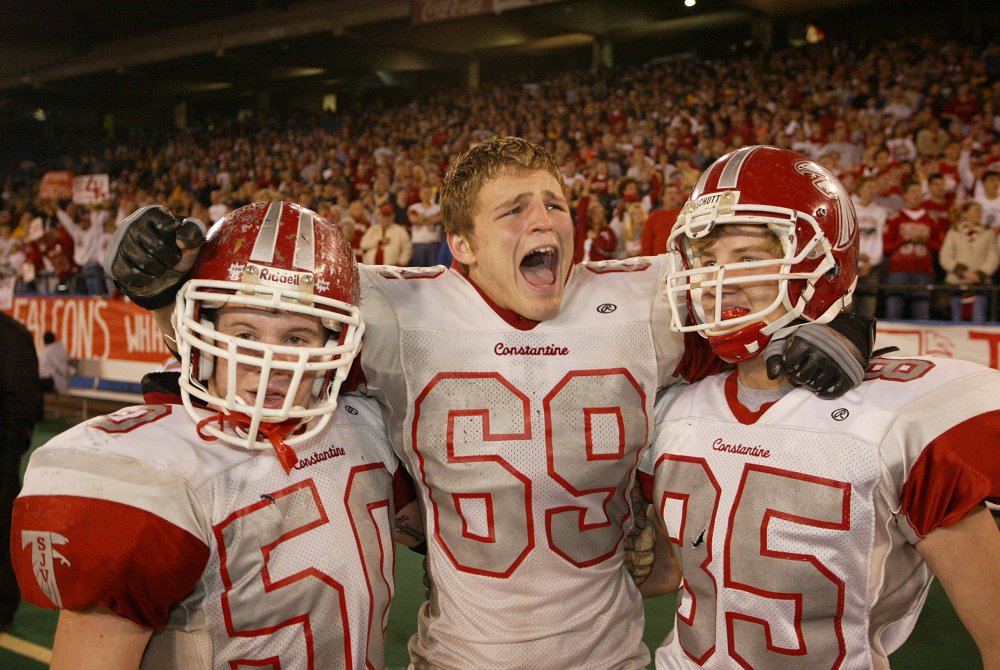
Constantine Celebrates 100th Season, Renowned for Continuity & Signature Wing-T
By
Scott Hassinger
Special for MHSAA.com
September 6, 2023
CONSTANTINE – Bennett Vandenberg and Cohen McGee are just like any other high school football players.
 Both Constantine seniors have high aspirations of winning a fifth-straight Southwestern Athletic Conference Lakeshore title and reaching the postseason.
Both Constantine seniors have high aspirations of winning a fifth-straight Southwestern Athletic Conference Lakeshore title and reaching the postseason.
But Vandenberg and McGee, along with their Falcons teammates, will be celebrating more than victories and a potential playoff appearance this fall.
Constantine, a community located in southern St. Joseph County, is observing the 100th season of the school's football program.
The Falcons (1-1) will commemorate the occasion Saturday, Oct. 7, with a home game against SAC Lakeshore foe Kalamazoo United. Kickoff time from Sweetland Stadium is 1 p.m. The game will be followed by a community luncheon and program in the high school at which time past coaches, players and the program's biggest accomplishments will be recognized and celebrated.
Vandenberg, a starting fullback/tight end and outside linebacker, and McGee, an offensive lineman and linebacker, are both looking forward to the rest of the season and continuing Constantine's strong tradition on the gridiron.
"We have a huge football tradition here at Constantine. This year we're celebrating the 100th year, and we have some of the oldest living players coming back to help celebrate after that game with United,” said Vandenberg, a three-year starter and Finals placer his junior year in wrestling and track & field. “Our community is all about football. We know we have to go out there and represent our school and community the right way."
McGee is following in the footsteps of his older brother Carter.
"There are lots of things that people who follow Constantine football don't see, like the hours of dedication and work we put in during the offseason. That's where we make our strides and become better as a program," McGee said.
The football stadium at Constantine is named after Dr. George Sweetland, a physician in the community, who donated money for a football stadium to be built with a hill completely circling the facility.
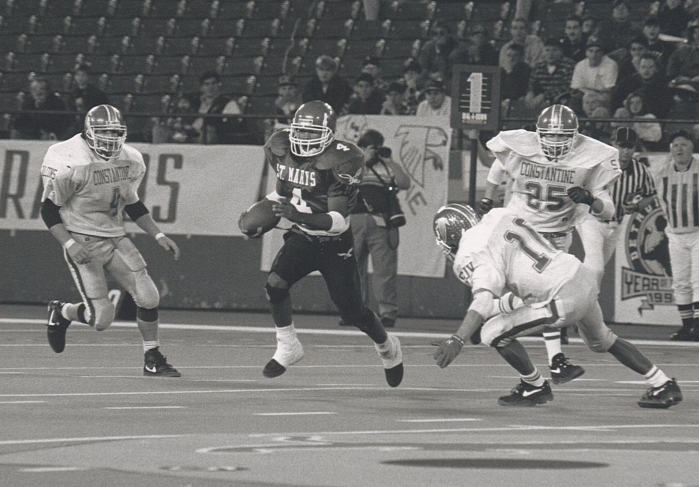 Sweetland, who moved to Constantine in 1916 to take over his brother's medical practice after the latter was killed in a car crash, reportedly allowed patients to work off their medical bills by helping with the stadium's construction.
Sweetland, who moved to Constantine in 1916 to take over his brother's medical practice after the latter was killed in a car crash, reportedly allowed patients to work off their medical bills by helping with the stadium's construction.
Constantine, which played its first football game in 1924 and finished as county champs at 4-2 under coach Lew Lake, sports an all-time record of 481 wins and 221 losses with 11 ties. During that span, the Falcons have enjoyed 11 unbeaten seasons, including Robert Finlay's 1937 squad that went 8-0 and was unscored upon.
Coaching longevity is one of the biggest factors allowing Constantine to be as successful as it has been, especially during the program's modern era. The Falcons have had just four head coaches since 1964.
Mike Messner, a three-sport athlete and 1965 Constantine graduate, later served as the school's athletic director from 1992-2016.
Messner pointed to Meredith 'Spud' Huston, Constantine's football coach from 1958-1961, as one of the first individuals influential in setting the wheels in motion for the program's future success.
Huston guided the Falcons to their first league title in 1961.
Constantine's four winningest coaches – Dave Horn, Tim Baker, Ken Rimer and Shawn Griffith – are all honorary members of the Michigan High School Football Coaches Association's Hall of Fame.
Horn, who died earlier this summer, served two stints as Constantine's head coach from 1964-1981 and 1987-1989 while compiling a 116-65-4 record.
Baker (129-30) coached Constantine for 15 seasons and guided the Falcons to a record of 129-30. Under Baker, the Falcons were Division 6 champs in 2004 and Finals runners-up in 1994 (Class CC) and 2002 (Division 5).
"Dave (Horn) was a genuinely great person who coached 21 years. He could get upset at you on the field, but he was a very kind, storyteller and a thoughtful guy who really cared about others," Messner said.
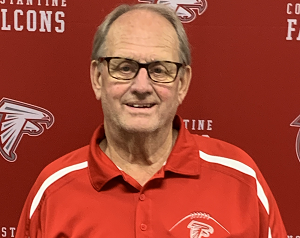 "In the modern coaching era, Tim (Baker) really believed in lifting weights, making kids stronger and developing kids into good football players. He was diligent, hardworking and put a lot of time into the program while missing a lot of family functions. He concentrated on doing the best job he could. Ken (Rimer) was right there in the same mode as Tim. When they started coaching together, they wanted a program that kids at Constantine could be proud of. Things started really happening, and ever since then the program has been strong. We have coaches who want Constantine to be successful on the field."
"In the modern coaching era, Tim (Baker) really believed in lifting weights, making kids stronger and developing kids into good football players. He was diligent, hardworking and put a lot of time into the program while missing a lot of family functions. He concentrated on doing the best job he could. Ken (Rimer) was right there in the same mode as Tim. When they started coaching together, they wanted a program that kids at Constantine could be proud of. Things started really happening, and ever since then the program has been strong. We have coaches who want Constantine to be successful on the field."
Rimer spent 28 years as an assistant coach under Baker and current head coach Shawn Griffith. Constantine compiled a win-loss mark of 242-70 with Rimer as an assistant.
Griffith, who took over as Constantine's head coach in 2005, is the Falcons’ all-time winningest coach at 156-53. Under Griffith's tutelage, the Falcons have made 17 playoff appearances, with back-to-back Division 6 runners-up finishes in 2011 and 2012.
"The history of Constantine football kind've coincides with everything else here in the community. This is my 32nd year overall as a coach in this program. But I also have several memories from when I was in high school at Mendon as a player going up against Constantine," Griffith said.
"When you talk about any community our size, you immediately look at family names. We have another Stears (Lucas) on this year's team. Mike (Messner) told me there have been over 20 from the Stears family that have worn the Falcon uniform. It doesn't stop there. I look at the number of kids we have in the locker room this year, and I realize that I've coached many of their brothers, fathers and uncles. We look at the program as one big family. This program has helped to raise a lot of young men in the area these last few years. The community has been extremely supportive of the program as well."
Constantine won 19 league championships as a member of the St. Joseph Valley League from 1952-2007. That league consisted of Constantine, White Pigeon, Schoolcraft, Centreville, Colon, Climax-Scotts, Burr Oak and Mendon. Bronson and Battle Creek St. Philip became members later after Climax-Scotts and Burr Oak left to join the Southern Central Athletic Association. Eventually, the SJV disbanded due to conference realignment and declining enrollment among its smaller schools.
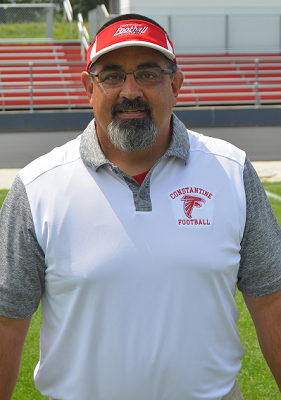 At one time, Constantine played in one of the longest-running rivalries in state football history. The Falcons and archrival White Pigeon began playing one another in 1924 and Constantine held a 47-35-6 in the rivalry, with wins in the final 17 meetings before the series ended after the 2007 season.
At one time, Constantine played in one of the longest-running rivalries in state football history. The Falcons and archrival White Pigeon began playing one another in 1924 and Constantine held a 47-35-6 in the rivalry, with wins in the final 17 meetings before the series ended after the 2007 season.
Messner recalls the 1981 meeting between White Pigeon and Constantine as one of the most memorable. The game was played at the Sweetland Stadium in Constantine, and there were more than 5,000 people in attendance.
"White Pigeon came into that game unscored upon and ranked No. 1 in the state. We were undefeated, but nobody was saying anything about us, but they were really talking (White Pigeon) up," Messner said. "(White Pigeon) had brought over 1,000 balloons with them and hid them behind the bleachers. They were going to launch them every time they scored. They never scored, and we beat them 21-0. It was such a sad moment for both schools when they had to stop playing one another in football."
After the SJV dissolved, Constantine and Schoolcraft became members of the Kalamazoo Valley Athletic Association from 2008-2014 before leaving to join the Southwestern Athletic Conference for the 2015 season. Constantine begins its ninth season competing in the SAC Lakeshore against the likes of Watervliet, Allegan, Kalamazoo United, South Haven and Parchment.
Messner also lists several playoff games as big moments in Constantine's football history.
"Our first playoff team (1991) was a big year, and our first state finals appearance (1994) was another," Messner added.
Constantine lost to Orchard Lake St. Mary's (35-7) in the 1994 Class CC Final, but knocked off heavily-favored Fennville (50-0) in their Pre-Regional and Whittemore-Prescott (54-6) in a Semifinal to get there.
"Both teams were considerably bigger than us up front on the line. Fennville had a really good quarterback (Frank Alfieri) and Whittemore-Prescott had a great tailback (Tom 'Touchdown' Tyson) that our much smaller guys managed to shut down," Messner said. "Then there was a 13-7 win we had in the 2002 Regional Finals over heavily-favored Muskegon Oakridge."
But perhaps the 2004 Semifinal deemed 'The Miracle in Marshall' will go down as the most memorable game in Constantine history. In that contest, Constantine trailed Monroe St. Mary Catholic Central 27-14 with a little more than six and a half minutes to go in the fourth quarter.
The Falcons scored twice during those last few minutes, including a last-second 32-yard TD pass from Aaron Baker to Sean Wolf caught in the end zone that tied the game at 27-27 with one second left. Jordan Williams booted the PAT as time expired, giving the Falcons a 28-27 win.
Constantine went on to defeat Suttons Bay 34-13 in the Division 6 Final the following week.
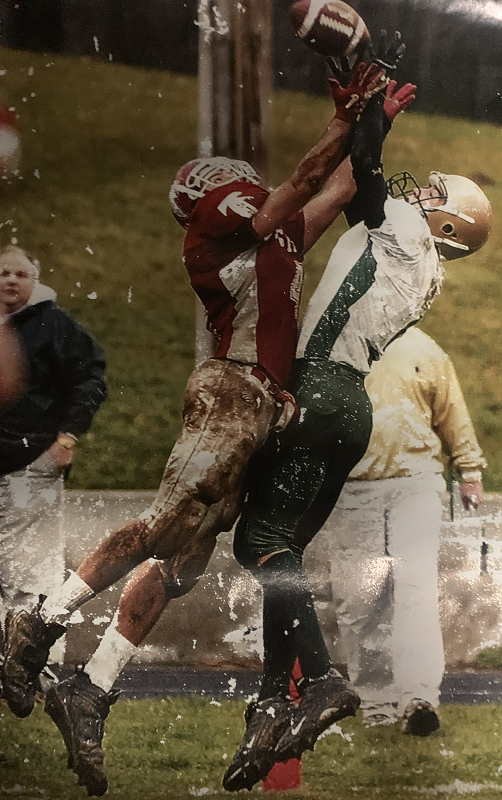 From 1991-2015, Constantine attained at least seven wins for 25 consecutive years, which is a state record. The Falcons made 18 consecutive playoff appearances from 1999-2016 before suffering their most recent losing season in 2017, when they finished 3-6.
From 1991-2015, Constantine attained at least seven wins for 25 consecutive years, which is a state record. The Falcons made 18 consecutive playoff appearances from 1999-2016 before suffering their most recent losing season in 2017, when they finished 3-6.
Constantine's overall playoff record stands at 49-25 with 26 total appearances.
It was Griffith, who played his high school football at Mendon for Class D championship-winning coach Roger Smith and his then-assistant John Schwartz (who would later lead the Hornets to 10 more Finals titles) who convinced Baker the Falcons should transition from the I-Formation to the Wing-T offense.
After much discussion and argument among the coaching staff, Baker reluctantly agreed to Griffith's idea.
"I joined the coaching staff in 1992 as offensive coordinator. As a coaching staff, we really came into our own and made our first run to the Finals in 1994. In the late ’90s we had some really good teams, but still didn't quite have a real identity. During that time we ran into some really good Wing-T football teams," Griffith said.
"We started noticing that we had a real hard time stopping these teams that ran the Wing-T like Muskegon Orchard View, Hopkins and Battle Creek Pennfield. So I came to Tim (Baker) after the 2001 season with the idea of changing the offense. We knew we had a tremendous group of running backs coming up through the program for the next seven or eight years. I approached him about running the Wing-T. He wasn't real receptive at first about running it. But after sitting down with other Wing-T coaches like John Shilito (Muskegon Orchard View) and Irv Sigler (Belding), he agreed to give it a try."
Constantine began running the Wing-T at the start of the 2002 season.
"Once you get known for running an offense like this, it kind've becomes your niche. I get emails from people all over the United States wanting me to come teach them this offense at camps. Here at Constantine, we've been fortunate to rack up quite a few wins since we installed this offense. Our kids can really talk the Wing-T game, and we didn't really have that before when we were running our I-formation and single-back stuff," Griffith said.
"The blocking schemes have become ingrained in our kids. They do a great job of knowing where they are supposed to be and who they are supposed to block. Another thing I really like about the Wing-T is it's a lineman's offense. Our linemen get a lot of credit, which they deserve. There is a certain toughness to this offense as well. It's allowed us to use kids who might be smaller and less athletic, but still allows us to be successful because they have developed a certain toughness."
Griffith credits a lot of that toughness to his players who compete on the Falcons' wrestling team during the winter sports season. Constantine’s wrestling program also has enjoyed a long run of success, including a Class C-D title in 1993 and Division 3 runner-up finish in 2002. The Falcons have won Team Regional titles three straight seasons.
 Scott Hassinger is a contributing sportswriter for Leader Publications and previously served as the sports editor for the Three Rivers Commercial-News from 1994-2022. He can be reached at [email protected] with story ideas for Berrien, Cass, St. Joseph and Branch counties.
Scott Hassinger is a contributing sportswriter for Leader Publications and previously served as the sports editor for the Three Rivers Commercial-News from 1994-2022. He can be reached at [email protected] with story ideas for Berrien, Cass, St. Joseph and Branch counties.
PHOTOS (Top) Constantine players celebrate near the end of their 2004 championship win at Pontiac Silverdome. (2) A trio of Constantine defenders pursue Orchard Lake St. Mary’s Phil Martin (4) during the 1994 Class CC Final. (3) Longtime Constantine athletic director Mike Messner. (4) Current Constantine head varsity coach Shawn Griffith. (5) The 2004 “Miracle in Marshall” remains one of the most memorable games in Constantine football history. (Finals photos from MHSAA archive. “Miracle in Marshall” photo by Dick Carter. Messner and Griffith photos gathered by Scott Hassinger.)

